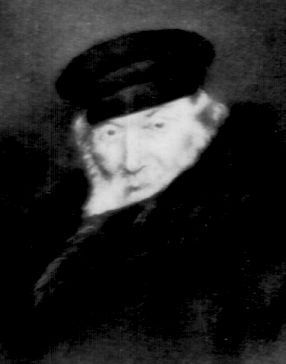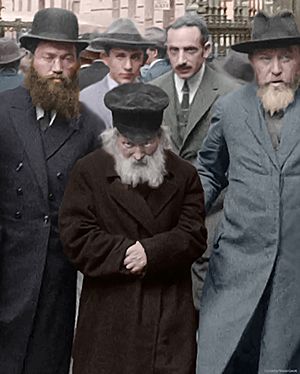Yisrael Meir Kagan facts for kids
Quick facts for kids Yisrael Meir Kagan |
|
|---|---|

Age 91, on his visit to the Polish Prime Minister
|
|
| Religion | Judaism |
| Personal | |
| Born | January 26, 1838 Dzyatlava, Grodno Governorate, Russian Empire |
| Died | September 15, 1933 (aged 94) (24 Elul 5693) Radun, Poland |
| Senior posting | |
| Title | The Chofetz Chaim |
| Signature |  |
Rabbi Yisrael Meir ha-Kohen Kagan (born January 26, 1838 – died September 15, 1933) was a very important Jewish leader. People knew him best by his nickname, the Chofetz Chaim. This name comes from his famous book about not speaking badly about others. He was also well-known for another big book called Mishna Berurah, which explains Jewish laws for daily life. He was a Lithuanian Jewish rabbi who taught about Jewish law and good behavior. His teachings are still very important in Orthodox Jewish communities today.
Contents
Who Was Rabbi Yisrael Meir Kagan?
Rabbi Kagan was born in 1838 in a place called Dzienciol, which is now Dzyatlava in Belarus. He passed away in 1933 in Radun, also in Belarus. His family name, Poupko, is not widely known. He used "Kagan" in official papers.
When he was ten years old, his father died. His mother moved the family to Vilnius so he could continue his Jewish studies. In Vilnius, he learned from Rabbi Jacob Barit. Later, his mother remarried and moved to Radin. At 17, he married his stepfather's daughter and made Radin his home.
How Did He Become a Rabbi?
For a short time, Rabbi Kagan served as the town rabbi of Radin. But he soon decided to leave that job. He wanted to start a special school called a yeshiva in the city. This yeshiva became very famous around the world.
He was known as a very humble and modest person. He was deeply dedicated to his Jewish faith. For a while, he even ran a small shop with his wife, selling things for the home. From 1864 to 1869, he taught Talmud in other cities like Minsk.
What Was the Radin Yeshiva?
In 1869, Rabbi Kagan officially opened his yeshiva in Radin. It was a big success and became known as "Yeshivas Chofetz Chaim of Radin". Besides teaching Torah through his school, Rabbi Kagan, now called "the Chofetz Chaim," worked hard for Jewish causes.
He traveled a lot to encourage Jews to follow Mitzvot (commandments) and keep Shabbat (the Sabbath). He became one of the most important rabbis in Orthodox Judaism in the late 1800s and early 1900s. He played a key role in the World Agudath Israel movement in Eastern Europe. He wrote many books about good behavior and ethics.
His Views on Zionism
Rabbi Kagan was worried about the anti-religious ideas in Zionism, which was a movement to create a Jewish state. At first, he didn't want to get involved publicly. But when his views became known, he warned his students not to join the Zionists. He believed their political goals went against the Torah.
He famously said it would be better to lose a third of the Torah knowledge in the world than to join the World Zionist Organization. This meant that even if many Jewish schools had to close, joining the WZO was not allowed.
Later Life and Family
In 1903, his first wife, Frieda, passed away. Two years later, he married Miriam Freida, who was much younger than him. They had a son, Rabbi Aharon Kagan, and a daughter, Feigl Chaya Sacks. His son-in-law was Rabbi Mendel Zaks.
In 1925, there was news that he would move to Petach Tikvah in Palestine. But other important rabbis convinced him to stay in Radin. He died there in 1933 at the age of 95 and was buried in the nearby cemetery. His second wife, Miriam Freida, later moved to Montreal and then New York, where she passed away in 1946.
His Legacy and Influence
Many Jewish schools and organizations around the world are named after Rabbi Kagan. For example, a yeshiva in Queens, New York, called Yeshivas Rabbeinu Yisrael Meir HaKohen, was founded by his great-nephew.
His teachings have also inspired groups like the Chofetz Chaim Heritage Foundation. This group works to share his lessons with Jewish communities everywhere. An Orthodox kibbutz (a community settlement) in Israel, Hafetz Haim, is also named in his honor.
During his life, both Jews and non-Jews respected Rabbi Kagan. Orthodox Jews saw him as one of the 36 righteous people who secretly help the world. Farmers in Poland even believed that if he walked in their fields, it would bring blessings to their crops.
Some stories say he didn't officially become a rabbi until late in life. He needed the title for his passport. He then received his official rabbinic ordination by telegraph from Rabbi Chaim Ozer Grodzinski. However, another report says he received it much earlier, at age 17.
Important Books by the Chofetz Chaim
Rabbi Yisrael Meir Kagan wrote many important books. Here are some of his most famous works:
- Chofetz Chaim (published in 1873): This was his first book. It teaches about the Jewish laws of gossip and slander, which is called Lashon Hara (meaning "Evil tongue") in Hebrew. It explains why it's so important to be careful with what you say.
- Shemirat HaLashon ("Guarding of the Tongue") (published in 1876): This book goes deeper into the ideas behind why Jews should be careful with their speech. It helps people understand the power of words and encourages them to use their speech ethically.
- Mishnah Berurah ("Clarified teachings") (published in volumes from 1884 to 1907): This is a very important and widely used six-volume commentary. It explains the Orach Chayim section of the Shulchan Aruch, which is a major book of practical Jewish Law. It includes his own explanations and different opinions from other rabbis.
- Biur Halacha ("Explanation of the Law"): This book is a detailed commentary that goes along with the Mishna Berurah. It often provides deep analysis of legal rulings from earlier Jewish law experts.
- Sha'ar HaTziyyun ("Gate of Distinction"): This book mainly lists the sources for the laws and customs mentioned in the Mishnah Berurah. It also sometimes helps to clarify unclear legal statements.
- Ahavat Chesed (published in 1888): This book is about the commandment to lend money to those in need. It also discusses the value of being kind to others and different ways to show kindness.
- Geder Olam (published in 1890): This book explains why it's important for married Jewish women to cover their hair.
- Chomas Hadas (published in 1905): This book talks about how important it is for men to study Torah and encourage others to learn. It also stresses the need for communities to have groups where men can study Torah.
- Tohoras Yisroel (published in 1910): This book explains the importance of women purifying themselves in a mikvah (a special ritual bath) according to Jewish law.
- Sefer Hamitzvos Hakotzor (published in 1931): This two-volume work covers the Biblical commandments that apply to Jews living outside of Israel, especially when the Temple in Jerusalem is not standing.
- Tzipita Lishuah ("Have you yearned for the redemption"): This book is based on a Jewish teaching that asks if a person has hoped for the coming of Moshiach (the Messiah). It explains why it's important to actively await the redemption every day and do good deeds to help bring it closer. Rabbi Kagan believed so strongly in the immediate redemption that he always carried special clothes to change into when it began.
Images for kids
See also
 In Spanish: Israel Meir Kegan para niños
In Spanish: Israel Meir Kegan para niños




